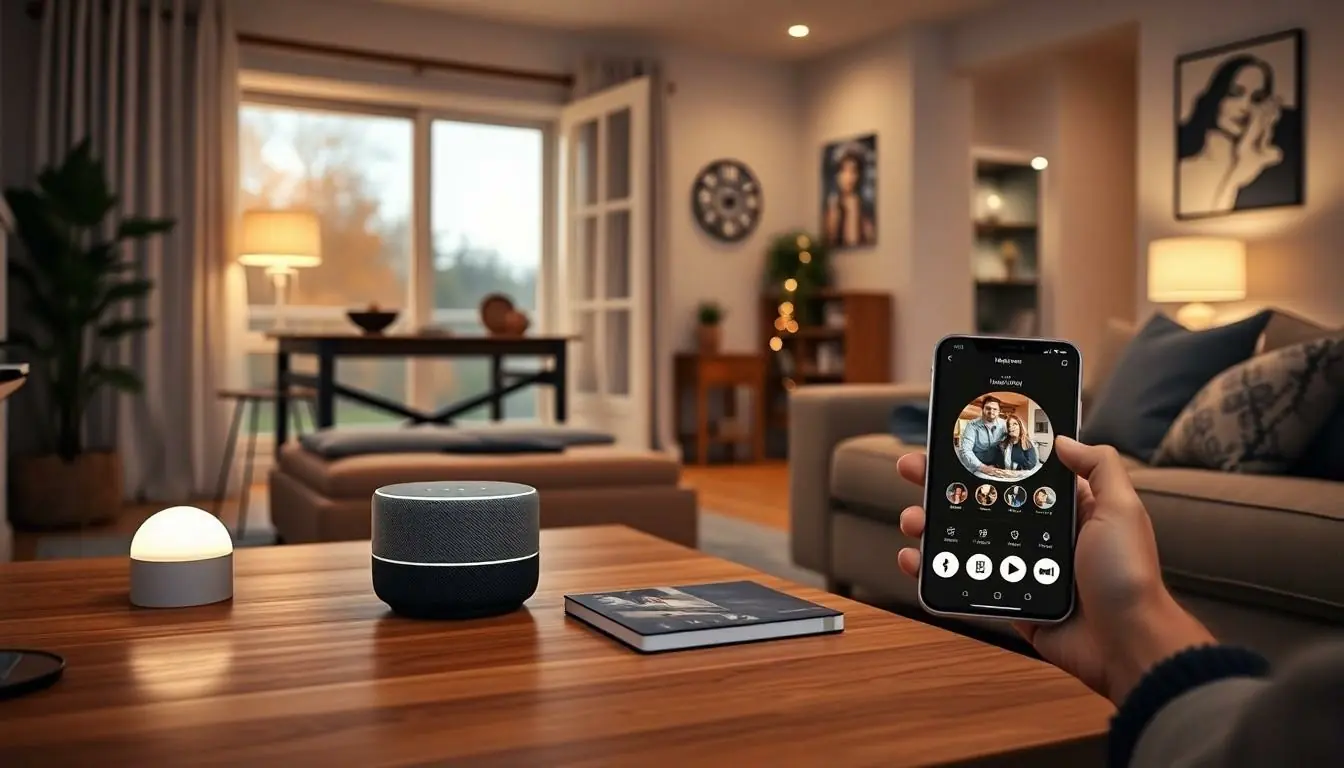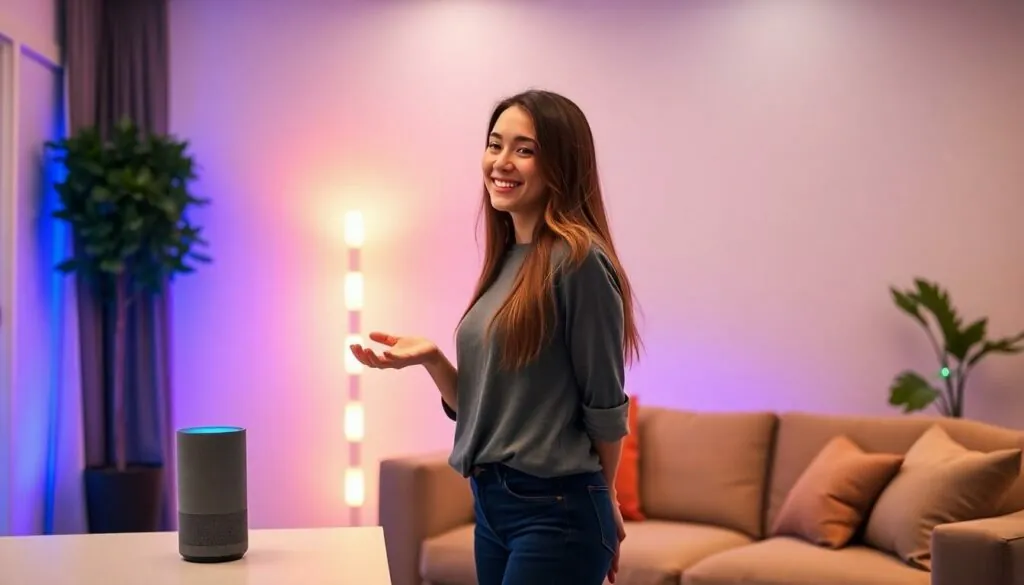Imagine waking up to the sound of your coffee brewing and your favorite tunes playing—all without lifting a finger. Voice-controlled home automation isn’t just a sci-fi dream; it’s the reality that’s transforming everyday living. With a simple command, lights brighten, thermostats adjust, and even the curtains draw back to reveal the day ahead.
Table of Contents
ToggleOverview Of Voice Controlled Home Automation
Voice-controlled home automation simplifies daily tasks by allowing seamless interaction with various devices using voice commands. This technology revolutionizes the way individuals manage their living environments, contributing to a more convenient lifestyle.
Definition And Concept
Voice-controlled home automation refers to the use of voice recognition technology to operate smart home devices. Individuals issue spoken commands to systems, such as smart speakers, which execute actions like adjusting lights, regulating temperature, and controlling appliances. The underlying concept relies on interconnected smart devices communicating with intuitive voice assistants. These systems enhance user experience by minimizing the need for physical controls while promoting efficiency in household management.
Advantages Of Voice Control
Voice control provides several significant benefits for users. First, it increases accessibility, allowing those with mobility challenges to interact easily with their environments. Second, it enhances convenience by enabling hands-free operation while multitasking. Third, energy efficiency improves as users can effortlessly adjust settings to optimize consumption. Additionally, voice control supports integration with various smart home products, creating a cohesive ecosystem that fosters comprehensive automation.
By prioritizing user experience and simplifying interactions, voice-controlled home automation adds immense value to modern living spaces.
Key Features Of Voice Controlled Home Automation

Voice-controlled home automation includes several essential features that enhance user experience and engagement. These features work together to create a seamless smart home environment.
Compatibility With Smart Devices
Compatibility with smart devices forms the backbone of voice-controlled home automation. Users can connect various devices like smart lights, thermostats, and security systems seamlessly. Leading brands such as Amazon, Google, and Apple offer compatibility with a wide range of products. This interconnectivity ensures users can control multiple devices from one command center, typically a smart speaker or a smartphone app. The integration creates a unified system where users streamline their daily activities efficiently. Smart hubs, like Samsung SmartThings, provide enhanced compatibility options, allowing users to manage devices from different manufacturers easily.
Natural Language Processing
Natural Language Processing enables intuitive interactions within voice-controlled home automation. This technology interprets user commands in natural speech rather than requiring specific phrases. Users communicate in their everyday language, making commands simpler and more accessible. Advanced voice assistants discern context and intent, so users can issue varied commands without repetition. This capability enhances user experience by allowing more conversational interactions. As machine learning algorithms continue to evolve, voice recognition improves, adapting to individual speech patterns and preferences for increased accuracy.
Popular Voice Controlled Home Automation Systems
Several prominent voice-controlled home automation systems enhance daily living by providing intuitive control over smart devices.
Amazon Alexa
Amazon Alexa stands out as a leading voice assistant. It connects effortlessly with various smart home devices, including lights, thermostats, and cameras. Users issue voice commands through Echo devices, enabling simple interactions. Compatibility with thousands of smart products broadens its versatility. Alexa supports routines, allowing users to execute multiple commands with a single phrase. This personalization enhances convenience and efficiency within the home. Additionally, Alexa’s natural language processing capabilities make interactions feel more conversational, adapting to individual speech patterns for increased accuracy.
Google Assistant
Google Assistant excels in integrating with Google’s ecosystem and other smart home devices. It easily connects to products such as smart bulbs, security systems, and smart TVs. Users call upon Google Assistant through devices like Google Nest, managing their homes with voice commands. Enhanced voice recognition allows for smooth conversations and task completion. Custom routines streamline daily activities, ensuring users can activate multiple functions at once. Google’s vast knowledge base ensures accurate responses and assistance, improving the overall user experience within a smart home setup.
Implementing Voice Controlled Home Automation
Implementing voice-controlled home automation involves carefully selecting compatible devices and effectively setting up the system.
Selecting The Right Devices
Choosing the right devices forms the foundation of a successful voice-controlled system. Smart speakers like Amazon Echo and Google Nest offer robust platforms for commanding other devices. Compatibility with smart lights, thermostats, and security systems enhances overall functionality. Users should prioritize devices that support popular voice assistants. Conducting research on device reviews and ecosystem compatibility helps streamline the selection process. Many devices offer easy integration with voice platforms, ensuring seamless interactions.
Setting Up The System
Setting up the system requires a structured approach. Begin by placing the smart speaker in a central location for optimal voice recognition. Connect smart devices through their respective apps, ensuring they are compatible with your chosen voice assistant. Creating routines enhances functionality by allowing users to automate multiple tasks with a single command. Customizing settings based on personal preferences further improves interaction efficiency. Regular software updates maintain system performance, ensuring smooth operation. With proper setup, users enjoy a cohesive and responsive smart home experience.
Challenges And Considerations
Voice-controlled home automation presents unique challenges that require careful consideration. These challenges are primarily focused on privacy, security, reliability, and connectivity.
Privacy And Security Concerns
Privacy and security pose significant challenges in voice-controlled automation. Smart devices often collect user data to enhance functionality, increasing the risk of personal information exposure. Hackers target voice-activated systems, making it essential to implement strong security measures. Users should frequently update device software and employ robust passwords to protect their networks. Enabling security features such as two-factor authentication further safeguards privacy. Understanding how data is stored and shared helps users make informed decisions about their smart device usage.
Reliability And Connectivity Issues
Reliability and connectivity represent critical issues for voice automation systems. Users may experience disruptions if devices lose internet access or encounter compatibility problems. A stable Wi-Fi connection is crucial for consistent performance. Placement of smart speakers can affect their effectiveness, leading to missed commands. Users should consider network bandwidth, especially when multiple devices operate simultaneously. Regularly rebooting devices and routers can help maintain a reliable connection, ensuring a seamless smart home experience.
Voice-controlled home automation is transforming how people interact with their living spaces. By embracing this technology, users can enjoy greater convenience and efficiency in their daily routines. The seamless integration of smart devices allows for effortless control over various home functions, enhancing both comfort and accessibility.
As advancements continue, the potential for voice control in home automation will only grow. Users can expect more intuitive interactions and improved compatibility across devices. By prioritizing security and connectivity, individuals can create a smart home environment that not only meets their needs but also aligns with their lifestyle. Embracing voice-controlled automation is a step toward a more connected and efficient home.





